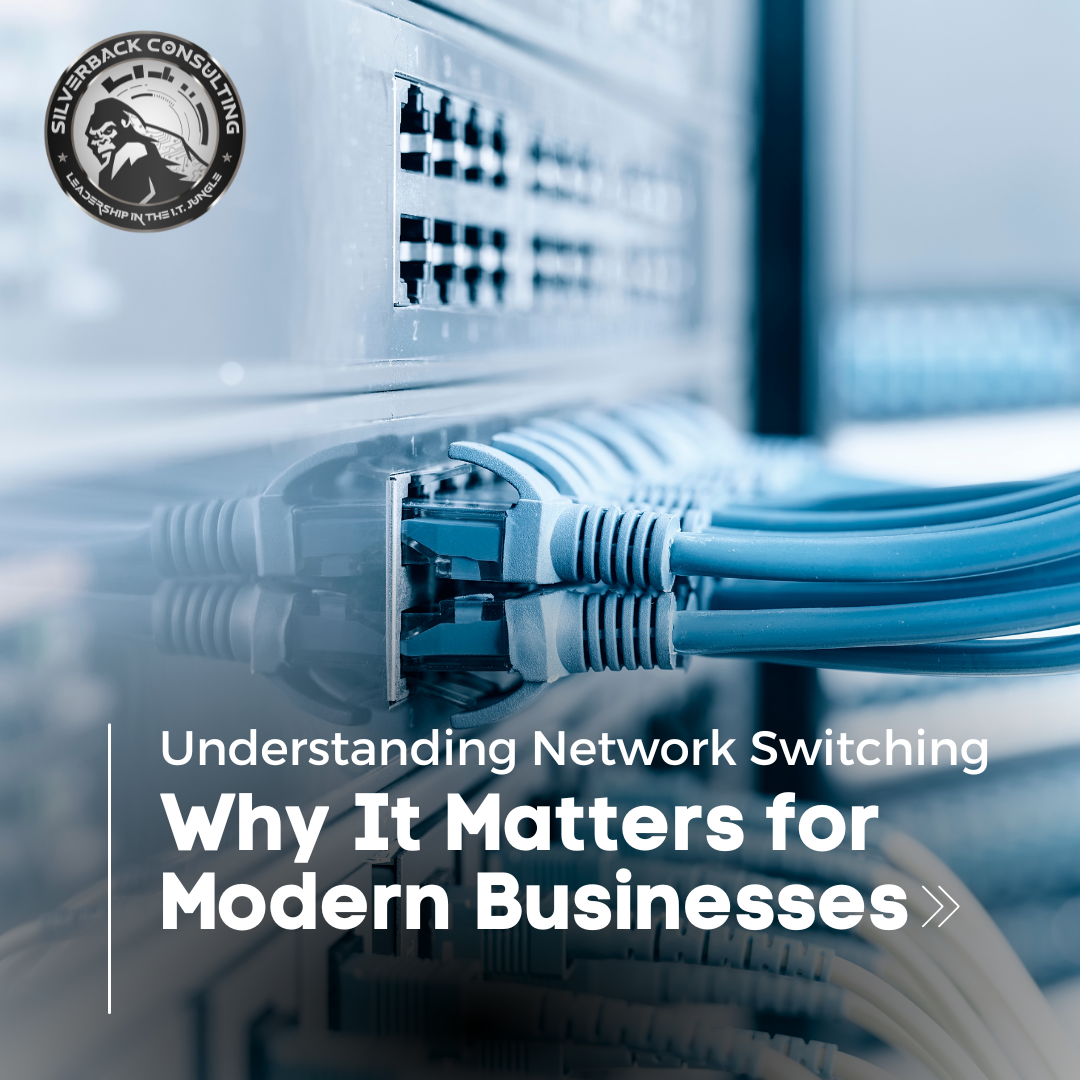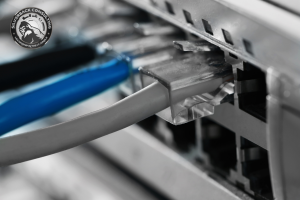Introduction
As a team of network consultants at Silverback Consulting, we often encounter questions like, “What is network switching?” and “Why do I need a switch if I already have a router?”
In this comprehensive guide we will demystify network switching, explain how switches work, and outline why they are essential for today’s wired and wireless networks.
By the end, network switches explained will no longer be a vague concept but a powerful tool in your infrastructure arsenal.
Why Your Business Needs Network Switching
2 Switch vs. Router: How Are They Different?
Many people confuse switches with routers because both direct network traffic. The difference is fundamental: routers select paths between networks (connecting your LAN to the internet), whereas switches operate within a network and send frames only to the destination device.
Routers rely on IP addresses at the network layer (Layer 3), but switches operate primarily at the data link layer (Layer 2) using MAC addresses.
3 How Do Network Switches Work?
When a switch is powered on, it doesn’t know which device is connected to each port. It builds a Content Addressable Memory (CAM) table by observing traffic.
Cloudflare explains that a Layer 2 switch maintains a table mapping MAC addresses to ports.
When computer A sends a frame to computer B, the switch records A’s MAC address and port, floods the frame to all other ports, and learns B’s address when B replies. From then on, the switch forwards traffic only to the correct port, reducing unnecessary broadcasts and collisions.
Switches support unicast (one-to-one), multicast (one-to-many), and broadcast (one-to-all) communication modes. This flexibility enables efficient data transfer by sending traffic only where it is needed.
Layer 2 vs. Layer 3 Switches
Most switches operate at Layer 2 of the Open Systems Interconnection (OSI) model.
A Layer 2 switch forwards frames based on destination MAC addresses and creates separate collision domains, reducing network congestion.
Layer 3 switches combine the high-speed switching of Layer 2 devices with routing capabilities; they forward traffic based on IP addresses and can route between virtual LANs (VLANs).
Cloudflare notes that some switches can perform both Layer 2 and Layer 3 functions, making them ideal for large networks that need both rapid switching and basic routing.
Managed vs. Unmanaged Switches
Switches are typically categorized as unmanaged, smart/partially managed, and fully managed.
- Unmanaged switches are plug‑and‑play devices with no configuration options. They’re suitable for home networks or small offices that simply need extra Ethernet ports.
- Managed switches offer sophisticated controls such as VLANs, Quality of Service (QoS), and Simple Network Management Protocol (SNMP). Administrators can prioritize traffic, implement security policies, and monitor performance.
- Smart (partially managed) switches provide limited management features at a lower cost, making them a compromise between unmanaged ease and full management.
Choosing the right type depends on network size and complexity. We generally recommend managed switches for growing organizations because they provide the flexibility to segment traffic, implement security policies, and support future expansion.
4 Key Features and Benefits of Network Switches

Error Checking and Full‑Duplex Communication
Network switches operate at the Data Link Layer, performing error checking before forwarding data, delivering frames only to the addressed device, and supporting full‑duplex communication.
Full‑duplex mode allows devices to transmit and receive data simultaneously, effectively doubling available bandwidth and reducing collisions.
Bandwidth Management and Transmission Modes
Switches allocate bandwidth to each LAN segment and support unicast, multicast, and broadcast transmission modes.
By directing frames only to the required ports, switches optimize the network and reduce unnecessary traffic.
Fortinet highlights that switches can dramatically improve network performance by allowing devices to communicate directly, thereby reducing congestion.
Scalability and Port Density
Switches offer easy scalability. They come in various port densities and can be stacked or used in modular form for future growth.
When your business expands, you can add more modules or stack additional switches without replacing existing infrastructure.
Efficient Data Transfer and Auto‑Negotiation
Switches forward data only to the intended recipient and use auto‑negotiation to determine the highest possible transfer speed supported by both endpoints. This ensures each device operates at optimal speed while maintaining compatibility within the network.
Standards‑Based Interoperability
Ethernet switches adhere to standards defined by bodies such as IEEE, ensuring that devices from different vendors interoperate seamlessly. This allows you to mix and match hardware without worrying about compatibility issues, which is critical for long‑term network design.
Security and Segmentation
While basic switches lack built‑in firewalls, advanced switches support features like Access Control Lists (ACLs), port security, and VLANs.
Segmentation using VLANs helps isolate sensitive traffic, minimizing the blast radius of potential security breaches.
Integrations with security platforms (such as FortiSwitch with Fortinet Security Fabric) further enhance protection.
5 Types of Network Switches Explained
In addition to managed and unmanaged categories, switches are grouped by function and deployment.
- LAN/Ethernet Switches (also called data switches) are the standard devices used in offices and campuses to connect wired devices.
- PoE (Power over Ethernet) Switches deliver power and data over the same Ethernet cable, simplifying deployment of wireless access points, IP cameras, and VoIP phones.
- Virtual Switches exist within virtualized environments, enabling VMs to communicate without leaving the host server.
- Routing Switches can perform basic routing functions to interconnect LANs and forward traffic between subnets.
- Smart/Partially Managed Switches offer limited control features compared to fully managed ones.
- Stackable Switches combine multiple physical switches into a single logical unit for simplified management and increased redundancy.
- Modular Switches accommodate additional modules or line cards, adding flexibility to support more interfaces or functions.
6 Why Are Network Switches Valuable?

Switches provide full‑duplex communication and wired connections for printers, IoT devices and wireless access points. They enable IoT devices and smart environments by supporting high volumes of traffic.
Fortinet further explains that by connecting devices directly, switches reduce congestion, support simultaneous communications, and allow networks to handle more traffic without sacrificing performance.
At Silverback Consulting we have observed that robust switching infrastructure is essential for:
- High‑Bandwith Applications: Video conferencing, cloud services, and real‑time collaboration depend on fast, low‑latency connections.
- Data Centers and Campus Networks: Data centers require scalable switches with high port densities to support virtualization and storage networking.
- Edge Computing and IoT: PoE switches simplify deployment of sensors, cameras, and access points, enabling smart buildings and industrial automation.
- Security and Compliance: Managed switches allow segmentation of sensitive data, helping meet compliance requirements by isolating regulated traffic.
7 Switching Techniques: Circuit, Message and Packet Switching
In the context of network switching, three fundamental switching techniques determine how data travels from source to destination:
- Circuit Switching establishes a dedicated path between sender and receiver for the entire communication session, as in traditional telephone networks. The path remains reserved even when no data is being sent.
- Message Switching sends the entire message as one unit; each intermediate node stores the message and forwards it when resources are available. This can introduce latency but doesn’t require a dedicated circuit.
- Packet Switching divides data into smaller packets and forwards them independently through the network. Packets may take different routes and are reassembled at the destination. Switches use packet‑switching techniques to efficiently forward frames based on destination addresses.
Modern Ethernet switches use packet switching because it maximizes network utilization and allows multiple communications to coexist on the same infrastructure.
8 Setting Up and Configuring a Network Switch
Setting up a small network switch is straightforward:
- Choose the Right Switch: Determine the number of devices and bandwidth requirements to decide on port count and speed.
- Connect to the Router: Plug the switch’s uplink port into your router; this extends available ports on the LAN.
- Connect Devices: Use Ethernet cables to connect computers, printers, and access points.
- Configure (Managed Switch): For managed switches, log into the web interface or console to configure VLANs, set port speeds, enable security features, and prioritize traffic using QoS.
For enterprise environments, proper planning is essential. We recommend designing VLANs aligned with organizational departments, implementing ACLs to restrict traffic,
9 Network Switching vs. Hubs and Bridges
Before the advent of switches, networks used hubs and bridges.
Hubs broadcast incoming frames to all ports, causing collisions and security issues.
Bridges separate collision domains but typically have only a few ports and limited performance.
Switches combine the functions of a multi‑port bridge with greater intelligence, using MAC address tables for precise forwarding, which results in higher efficiency and security.
10 Emerging Trends in Network Switching
- Software‑Defined Networking (SDN) decouples the control plane from the data plane, allowing centralized network management. Many modern switches support protocols like OpenFlow for SDN integration.
- Network Virtualization uses virtual switches within hypervisors to connect virtual machines, enabling flexible deployment without physical hardware changes.
- High‑Speed Ethernet: Businesses are moving to 10 GbE, 40 GbE, and 100 GbE switches to handle bandwidth‑intensive workloads such as video streaming and cloud services.
- AI‑Driven Network Management: Machine learning algorithms optimize traffic flows, detect anomalies, and predict failures.
At Silverback Consulting, we continually evaluate and implement advancements to keep our clients’ networks resilient and future‑proof.
11 Conclusion: Choosing the Right Switching Solution
Understanding what is network switching and selecting the right switch type are critical decisions that affect performance, scalability, and security.
Switches operate at the heart of modern networks by connecting devices, reducing congestion, and enabling efficient data transfer. They provide the foundational infrastructure for IoT deployments, cloud connectivity, and enterprise communications.
When selecting a switch, consider the size of your network, future growth, security requirements, and budget.
Unmanaged switches may suffice for simple setups, but managed switches offer the configurability and control necessary for business‑class environments.
Layer 3 switches add routing capabilities that can simplify network architecture.
If you have further questions or need assistance with network switches explained, we invite you to contact our team at Silverback Consulting. We design, implement, and manage switching solutions tailored to your business needs—ensuring your network is optimized for reliability, performance, and security.
12 What does a network switch do?
A network switch connects devices within a local network and forwards data directly to the intended device. Unlike a router, which sends data between networks, a switch only delivers packets to the specific device they’re meant for, minimizing unnecessary traffic.
13 How does a network switch work?
Switches use MAC addresses to direct traffic. When a device first communicates, the switch records its MAC address and port in a CAM table. Unknown traffic is briefly “flooded” to all ports until the switch learns the destination, after which it forwards packets only where they belong.
14 What does a network switch actually do in my office?
In a typical office, a switch expands the number of wired connections, letting printers, phones, workstations and access points communicate reliably. It ensures each device gets bandwidth, handles data efficiently, and cuts down on collisions—especially important when multiple users access large files or video calls simultaneously.
15 Do I really need a network switch if I already have a router?
A router connects your local network to the internet and forwards data between networks, while a switch connects devices within the network. If your router doesn’t have enough ports or you want to segment traffic and improve performance, adding a switch makes sense. For a very small home network, a router alone may suffice.
16 Can you explain network switching in simple terms?
Think of a switch as a receptionist who knows which room everyone is in. When someone delivers a message, the receptionist looks up the recipient and sends it directly to their room instead of shouting down the hallway. This targeted delivery keeps communications private and efficient.
17 Why would a small business invest in network switching services?
Professional switches reduce congestion by allowing devices to communicate directly and in full duplex (send/receive simultaneously), improving speed and reliability. They scale easily as your team grows and let you segment traffic for security and performance. Managed switching services ensure these benefits are configured correctly for your needs.
18 What’s the difference between a network switch and a router for my small business?
A router connects your network to the internet and between networks, while a switch connects devices inside the network. Routers assign IP addresses and direct internet traffic; switches use MAC addresses to efficiently forward data within your office.
19 If I already have Wi‑Fi, do I still need a network switch?
Wi‑Fi handles wireless devices, but wired connections are still crucial for servers, printers, VoIP phones, and high‑bandwidth tasks. A switch gives you more Ethernet ports and a stable connection for these devices. For environments where you rarely plug in devices, Wi‑Fi alone might suffice.
20 Will a switch make my internet faster compared to just using a router?
A switch doesn’t increase your ISP’s internet speed. However, it does eliminate local bottlenecks by enabling direct, full‑duplex communication. That means file transfers, backups and internal traffic won’t compete with each other, which can make your network feel faster overall.
21 How do I connect more devices without slowing down my network?
Adding a switch expands your network’s port count and provides each connected device with dedicated bandwidth. Managed switches also let you prioritize critical traffic and segment users into VLANs, keeping performance consistent.
22 How does a managed switch reduce network congestion?
Managed switches allow you to segment traffic into VLANs, prioritize critical applications with Quality of Service (QoS), and monitor bandwidth usage. This ensures heavy workloads don’t overwhelm the entire network and keeps business-critical services running smoothly.
23 Should my business invest in a Layer 2 or Layer 3 switch?
A Layer 2 switch is often enough for small offices that only need fast, local connectivity. If your business requires routing between multiple VLANs or has more complex traffic patterns, a Layer 3 switch may be worth the investment for its built-in routing capabilities.
24 Do Layer 3 switches replace routers?
Layer 3 switches can handle basic routing tasks within your LAN, but they don’t fully replace routers. You’ll still need a router to connect your network to the internet and manage advanced functions like firewalls, VPNs, and NAT.
25 Is it difficult to configure managed switches?
Managed switches do require setup, but most offer user-friendly interfaces with web dashboards or command-line tools. For businesses without in-house IT staff, professional configuration ensures that security, VLANs, and QoS are implemented correctly from the start.
26 Are there affordable managed switch options for small businesses?
Yes. Many vendors offer entry-level managed switches with essential features like VLANs and QoS at a reasonable price. These options give small businesses the benefits of control and flexibility without the cost of enterprise-grade hardware.
27 Which type of switch is best for connecting my server and workstations?
A Gigabit Ethernet managed switch is typically best for servers and workstations, as it provides high-speed, stable connections with the ability to prioritize traffic. For data-intensive environments, consider a 10 GbE switch for even greater throughput.
28 What is a PoE switch and when should I use one?
A Power over Ethernet (PoE) switch supplies both power and data through a single Ethernet cable. They’re ideal for devices like IP cameras, VoIP phones, and wireless access points where running separate power lines would be inconvenient or costly.
29 Can I use a virtual switch if I’m running virtual machines?
Yes. A virtual switch operates inside a hypervisor (like VMware or Hyper-V) and lets your virtual machines communicate with each other and the physical network. This is essential for businesses running virtualization, as it reduces hardware needs while keeping traffic secure and organized.
Take Control of Your Network Today
Ready to optimize your business with smarter, faster, and more secure connectivity? Silverback Consulting specializes in designing and managing custom network solutions built around your needs. Don’t let outdated infrastructure slow you down—reach out today. Call us at (719) 452-2205 or simply fill out the contact form below to get started.
Silverback Consulting
303 South Santa Fe Ave
Pueblo, CO 81003
719-452-2205
support@silverbackconsulting.us
“Leadership in the I.T. Jungle”




 A network switch is a piece of networking hardware that connects devices within a local area network (LAN) and forwards data between them based on Media Access Control (MAC) addresses.
A network switch is a piece of networking hardware that connects devices within a local area network (LAN) and forwards data between them based on Media Access Control (MAC) addresses.
